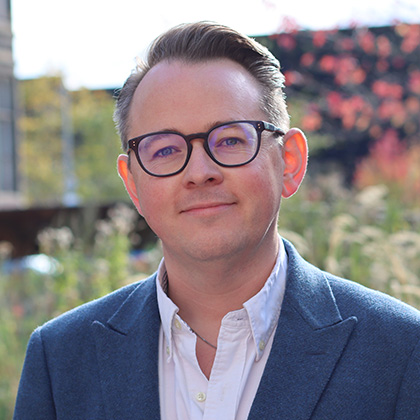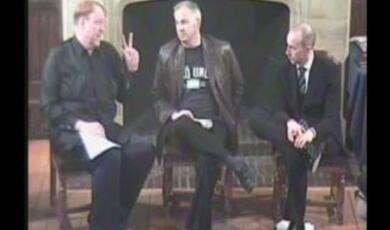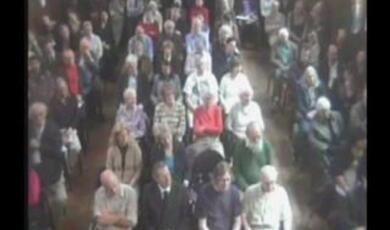Shakespeare’s Musical Fairies
Share
- Details
- Text
- Audio
- Downloads
- Extra Reading
Written in the era of the founding of Gresham College, Shakespeare’s A Midsummer Night’s Dream portrays the hypnotic dreaminess of a fairy world in which the real and the fantastic are blurred. This lecture explores how the innate musicality of Shakespeare’s original has provoked adaptations across the centuries, including Ashton and Balanchine’s ballets based on Mendelssohn’s incidental music for the play, Britten’s opera, Purcell’s masque The Fairy Queen, Henze’s Eighth Symphony and Elvis Costello’s Il Sogno. What is it about Shakespeare’s fairies that have inspired such diverse musical responses?
With special guests, classical singer Nathan Mercieca and actors Ian Drysdale and Sara Kestelman.
Download Text
Shakespeare’s Musical Fairies
Dominic Broomfield-McHugh, Visiting Professor of Film and Theatre Music
22 September 2025
On Fairy Tales
Fairy tales often connect fairies with sound, and particularly with music, as a matter of course. The iconic 1950s live broadcasts of Peter Pan on NBC showed Broadway star Mary Martin interacting with Tinkerbell in human language but the responses come in the form of a xylophone (the ‘tinker bell’). This is just one of the many widely-enculturated ideas we associate with fairy tales – indeed, Carl Jung was convinced that they provided the key to the ‘collective unconscious’. While we might not agree with his much-contested views, it’s hard not to agree that fairy tales – in all their regional and historical variations – provide insights into the kinds of stories we refer to in order to understand the world around us. For instance, Disney’s and Tchaikovsky’s versions of Sleeping Beauty (1959 and 1890 respectively) provide familiar images of the immaculately dressed Princess Aurora sleeping serenely as she awaits the Prince to come and kiss her back to life. The use of the waltz and the visual glamorisation of the scenarios romanticises the plot, but more contemporary interpretations of the tale recognise the problems of inscribing passivity as ‘feminine’. Miles Aldridge’s portraits for The Face (2000) render the beauty’s image in a grittier context: covered in flies, her body is immaculate but not protected from the realities of nature.
Many of the tropes familiar from dramas of all kinds also seem to derive from ideas that we see in fairy tales. For example, many fairy tales involve leaving a castle or house and wandering out into the garden or woods in order to provide catharsis of some kind, and often these have led to poignant or striking moments in musical adaptations of these stories. In Act 4 of Mozart and Da Ponte’s Le nozze di Figaro the Countess Almaviva and her maid Susanna switch dresses in the garden in order to trick the Count and reveal his infidelity: the problems of the house ‘come out into the open’ when the characters go into the grounds. In another recognisable example, Hansel and Gretel must get lost in the woods in order to be found: the moral of the story comes from leaving the man made safety of the home and encountering the supernatural through the forest. An American manifestation of this trope comes in Baum’s novel The Wizard of Oz, musicalized by MGM in 1939: the Lion (who wants to be King of the Forest), Dorothy, Tin Man and Scarecrow must traverse the Yellow Brick Road through the woods in order to reach the Emerald City where they will ‘find’ themselves. It’s such a common trope, in fact, that by the time Sondheim and Lapine wrote Into the Woods (1987), their clever combination of numerous fairy tales into one story focused on all the characters encountering one another in the woods to learn something about themselves. The title song that opens the musical draws attention to this as both a convention and a compulsion: Red Riding Hood sings ‘Into the woods, it’s time, and so I must begin my journey’.
Shakespeare’s A Midsummer Night’s Dream
Shakespeare knew the real-life Forest of Arden and set his As You Like It within it. But a forest also provides the setting for the focus of today’s lecture, which is A Midsummer Night’s Dream. The plot recounts how four Athenian lovers resolve their social tensions through the intervention of the fairies, led by King Oberon and Queen Titania, who play tricks on them (and each other) in the forest. The woods also form the setting for the rehearsals of the mechanicals or workers, who decide to perform a classical play, Pyramus and Thisbe, for the wedding of Theseus and Hippolyta. The mechanicals, too, end up interacting with the fairies, notably when Bottom the weaver ends up with the head of an ass, in love with Titania after Oberon has intervened with the help of his wingman, Puck.
What’s clever about the play is the way in which Shakespeare fuses ideas from diffuse sources to create the plot of the Dream. The Athenians’ stories come from Chaucer, Thomas North, and Plutarch; Puck comes from The Discoverie of Witchcraft by Reginald Scot; Bottom and Titania come from a translation of the old story of The Golden Ass; Oberon comes from The History of Huon of Bordeaux; and Ovid provides Pyramus and Thisbe; there are various other identifiable or claimed sources as well. The sheer cleverness of the play has been regularly admired:
‘A Midsummer Night’s Dream is outside as well as above all possible imaginative criticism. It is probably or rather surely the most beautiful work of man. No human hand can ever have bequeathed us anything properly or rationally comparable with this.’
Algernon Swinburne, Shakespeare (OUP, 1909)
Yet such admiration can also obscure the fact that at heart, the mixture of plots and genres in this unusual play includes some sources that are far from elevated. In particular, the Bottom-Titania plot is along the lines of Beauty and the Beast, and this became the focus for interpretations in visual art (e.g. Chagall’s Dream from 1939). On the other hand, the real point of the play may be that the fairies aren’t really fairies at all but rather manifestations of human fantasy and desire. Dame Judi Dench, who played Titania in three productions, explained how she views the fairies:
‘Titania and Oberon are a couple at war who happen to be Queen and King of the Fairies. Your job as an actor is to find the humanity: something that the audience can identify with. In this case it’s two people having a blazing row.’
Judi Dench, Shakespeare: The Man Who Pays the Rent, 27
In Peter Brook’s landmark production from 1970, it was made explicit that Titania and Oberon are the alter egos of Theseus and Hippolyta, right down to giving them the same costumes.
A Midsummer Night’s Dream in Music
Shakespeare’s Dream has inspired numerous pieces of music, ranging from settings of individual songs (Vaughan Williams) to incidental music for a performance of the play (Mendelssohn) to an operatic adaptation (Britten). The play recounts disharmony at the end of a day in an old society (act 1) and moves via nocturnal adventures (acts 2-4) to harmony through a triple marriage (act 5). In itself, this is hung around a musical structure, whereby the music of the night brings social harmony. But more specifically, the reason why this play has given rise to so many musical treatments is that the fairies are inherently musical (as we learnt from Tinkerbell). Titania in particular regularly refers to music: in Act 2, she demands that the other fairies sing her a lullaby so she can go to sleep, and she later falls in love with Bottom when she hears him sing to her.
Music has also been central to the reception of the play. In the Gresham College Music Library, we have a number of rare scores related to the Dream, including a remarkable songbook in the hand of Henry Purcell, containing six arias from The Fairy Queen (1692). This was a ‘semi-opera’ in which Shakespeare’s text was condensed and musical diversions were added to the beginnings and ends of the acts. But Purcell also adds a beautiful musical sequence that extends Titania’s descent into sleep: four allegorical characters each have a short aria, Night, Mystery, Secresie, and Sleep. (In the lecture, we’ll hear Secresie’s aria.)
This denotes a greater emphasis on fairies in productions of the play from the Restoration (1660) onwards. Musical versions tended to make them the heart of the plot: an operatic adaptation by the actor David Garrick from 1755, with music by Handel’s pupil J C Smith, was actually called The Fairies.
Wagner, Mendelssohn and Orff
In the eighteenth century, Shakespeare was adopted by the Germans, with figures such as Goethe admiring his work as some of the greatest in humanity. The Schlegel-Tieck translation of the complete plays was regarded as a triumph of German literature, and in 1796 Schlegel actually said that Shakespeare was ‘ganz unser’ (completely ours). Reading the Schlegel translation of the Dream led a 17 year old Felix Mendelssohn to write an overture inspired by the play. The Fairies, the Athenians, and even the braying of Bottom as an ass are clearly depicted in the music, and it led to Mendelssohn being established as a major composer. In
1842 he was then commissioned by the King of Prussia to expand the overture into full incidental music for a production of the play, including songs, dances, scene change music and underscoring. The fairies and their nocturnal world provided the perfect subject for a century fuelled by the Romantic imagination and its supernatural stories.
Richard Wagner was among the great Romantic composers of music based on supernatural topics, but his anti-Semitic invectives against Mendelssohn led to the latter’s ban by Goebbels during the Third Reich; this was a particularly drastic move, because Mendelssohn’s music had become synonymous with the play by the twentieth century. One of music history’s most notorious acts is Carl Orff’s willingness to write new incidental music for the play in response to a call for a version to replace Mendelssohn’s: it was first performed in Frankfurt in 1939, though Orff had been interested in the play for many years. The outcome was the suppression of Mendelssohn’s great work. But in America, the Jewish composer Erich Korngold, who had led Europe in 1934, had already completed a project that would keep Mendelssohn’s music alive: upon arriving in Hollywood, his first job was to arrange Mendelssohn’s music (as well as other pieces by the composer) for a 1935 film version by Max Reinhardt. At times, the results border (ironically) on the Wagnerian, but the Korngold-Mendelssohn music was widely admired as a key feature of the film.
Britten and Pears’ Dream
The other major twentieth century musical setting of the play was Benjamin Britten’s opera, with a libretto adapted by himself and his partner Peter Pears. They must have been attracted by the queer potentiality of Oberon, whose sexuality has often been depicted as fluid (e.g. in modern interpretations by Rupert Everett and Alex Jennings). Britten wrote an article for The Observer in which he observed, ‘I have always been struck by a kind of sharpness in Shakespeare’s fairies… besides, they have some odd poetry to speak – the part about ‘you spotted snakes with double tongue’ for instance. The Fairies, are, after all, the guards to Titania: so they have, in places, martial music. Like the actual world, incidentally, the spirit world contains bad as well as good.’ The libretto minimizes the importance of the Athenians and sets the opera in the dreamworld of the fairies, with their nocturnal mystery; this replaces the sense of ‘performance’ in the play with a sense of the subconscious. And the Britten scholar Philip Reed refers to ‘the dangerous attraction of Oberon’ in Britten’s setting, which was for the countertenor Alfred Deller. This was a highly unusual vocal type in 1960, though Purcell – whose music Britten adored – wrote widely for the countertenor, and was a countertenor himself, thus linking the two (indeed, Britten created his own edition of The Fairy Queen with Imogen Holst).
Britten and Pears’ Dream
The writer G.K. Chesterton provides an explanation of the final scene of the play, when Titania and Oberon return to bless the house after the wedding festivities are over:
‘…and so the play seems naturally ended. It began on the earth and it ends on the earth…Theseus and his train retire with a crashing finale, full of humour and wisdom, and things set right, and silence falls on the house. Then there comes a faint sound of little feet, and for a moment, as it were, the elves look into the house, asking which is the reality. “Suppose we are the realities and they are the shadows.” If that ending were acted properly any modern man would feel shaken to his marrow if he had to walk home from the theatre through a country lane.’
G. K. Chesterton, Good Words, 45 (1905)
And the blessing is made is song, which confirms that music is at the heart of this play and its fairy land:
OBERON
‘And this ditty, after me,
Sing, and dance it trippingly.’
TITANIA
‘Hand in hand, with fairy grace,
Will we sing, and bless this place.’
The Dream was not Shakespeare’s only or last play involving musical fairies, of course, and it would be remiss not to acknowledge one other important example. In his late-career The Tempest (c.1616), the spirit Ariel not only acts as Prospero’s eyes and ears, but also enacts Prospero’s spells through song (e.g. when luring Ferdinand). Ariel’s magic is frequently performed through music, and he has to sing four numbers in the play (so the original actor must have been a competent singer). Michael Tippett’s Songs for Ariel (1962) were written for a production of the play at the Old Vic, and their ethereal quality underscores how music provides liminality, whereby the corporeality of human existence is transcended through sounds; these beautiful settings match the mysterious music of Prospero’s enchanted island. And as Prospero reminds us, none of what we have heard is real: ‘we are such stuff as dreams are made on.’
© Professor Dominic Broomfield-McHugh 2025
Further Reading
Benjamin Britten, ‘A new Britten opera’, The Observer, 5 June 1960
Britten: A Midsummer Night’s Dream, ENO Guides (Overture, 2011)
Richard Danson Brown and David Johnson, A Shakespeare Reader (Macmillan, 2000)
G. K. Chesterton, Good Words, 45 (1905)
Judi Dench, Shakespeare: The Man Who Pays the Rent (2024)
Marie-Louise von Franz, The Interpretation of Fairy Tales (Shambhala, 1996)
E.M. Forster, Aspects of the Novel (Penguin, 1962)
Dorothea Kehler, A Midsummer Night’s Dream: Critical Essays (Routledge, 2001)
Roger North, The Musicall Grammarian (rep. CUP, 2006)
Algernon Swinburne, Shakespeare (OUP, 1909)
Editions
Grace Ioppolo, A Midsummer Night’s Dream (Norton, 2018)
Virginia Mason Vaughan and Alden T.Vaughan (eds.), The Tempest, The Arden Shakespeare (Bloomsbury, 2011)
Stanley Wells, A Midsummer Night’s Dream (Penguin, 1967)
Filmography
A Midsummer Night’s Dream, dir. Max Reinhardt, 1935
A Midsummer Night’s Dream, dir. Adrian Noble, 1996
A Midsummer Night’s Dream, dir. Michael Hoffman, 1999
Benjamin Britten, ‘A new Britten opera’, The Observer, 5 June 1960
Britten: A Midsummer Night’s Dream, ENO Guides (Overture, 2011)
Richard Danson Brown and David Johnson, A Shakespeare Reader (Macmillan, 2000)
G. K. Chesterton, Good Words, 45 (1905)
Judi Dench, Shakespeare: The Man Who Pays the Rent (2024)
Marie-Louise von Franz, The Interpretation of Fairy Tales (Shambhala, 1996)
E.M. Forster, Aspects of the Novel (Penguin, 1962)
Dorothea Kehler, A Midsummer Night’s Dream: Critical Essays (Routledge, 2001)
Roger North, The Musicall Grammarian (rep. CUP, 2006)
Algernon Swinburne, Shakespeare (OUP, 1909)
Editions
Grace Ioppolo, A Midsummer Night’s Dream (Norton, 2018)
Virginia Mason Vaughan and Alden T.Vaughan (eds.), The Tempest, The Arden Shakespeare (Bloomsbury, 2011)
Stanley Wells, A Midsummer Night’s Dream (Penguin, 1967)
Filmography
A Midsummer Night’s Dream, dir. Max Reinhardt, 1935
A Midsummer Night’s Dream, dir. Adrian Noble, 1996
A Midsummer Night’s Dream, dir. Michael Hoffman, 1999
This event was on Mon, 22 Sep 2025
Support Gresham
Gresham College has offered an outstanding education to the public free of charge for over 400 years. Today, Gresham College plays an important role in fostering a love of learning and a greater understanding of ourselves and the world around us. Your donation will help to widen our reach and to broaden our audience, allowing more people to benefit from a high-quality education from some of the brightest minds.


 Login
Login







